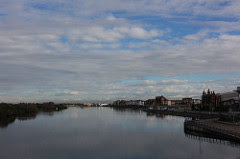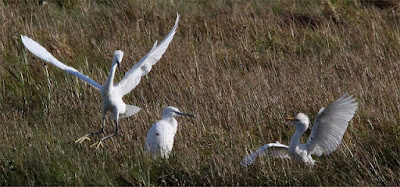 |
| Sketch map of Southport |
Marshside is well worth a few hours' attention any time of year. In Winter there are ducks, geese and golden plovers in their thousands, in Summer there's a large breeding colony of black-headed gulls and breeding avocets, and the Spring and Autumn migrations can throw up some nice surprises.
If you've the time and energy, and the weather's not misbehaving,
the walk from Southport along the Marine Drive can be productive. Similarly a
walk down from Crossens. Alternatively, you could get a bus from Southport:
- The 44 will take you to Marshside Road and the centre of the RSPB reserve
- The 40 will take you to Hesketh Road and the southern end of the reserve
I'm not a local so there may be a few more options worth exploring.
If you're planning on getting the bus there and back it might be worth your while buying a Saveaway ticket from the office in the station.
To Marshside Road
Turn right as you come out of the station and carry on walking and you'll cross London Road and onto Hoghton Street. The bus stop for the 44 is a few yards down the road. This bus goes out to Crossens via Marshside. The blue line on the map follows the bus route as far as the bottom of Marshside Road, get off here and walk a hundred yards or so down to the RSPB reserve.
 |
| Marshside from Marine Drive |
You've now got four choices:
- Carry on down to the bottom of the road and follow the path round to the main hide, Sandgrounders.
- Carry on down to the bottom of the road, turn left, have a look at the Junction Pool on the corner and then follow the path down to Nels Hide.
- Turn right and take the path along the back of the reserve and walk down to Crossens (the red line running north-east on the map).
- Turn left and take the path along the back of the reserve and through the golf course down to Hesketh Road (the red line running south-west on the map).
The first two options give you good views of the pools. The last two get you a bit closer to some of the waders on the smaller pools and ditches. Given time, energy and decent weather conditions in Autumn a full circuit of the reserve is well worth the effort.
 |
| Black-tailed godwits |
In Winter there are a lot of wildfowl — greylag and pink-footed geese, wigeon, pintail, teal, shoveler and tufted ducks — and huge numbers of waders, mostly black-tailed godwits, lapwings and golden plover. Mallard and gadwall can be seen all year round, as can the little egrets. There's always a chance of seeing one or more of the cattle egrets that move around the Sefton Coast (if you're lucky enough to see one be careful to look for some more: there were up to half a dozen around this Autumn).
 |
| Cattle egrets |
Avocets breed here in Summer and Sandgrounders overlooks a large black-headed gull breeding colony which sometimes includes a few pairs of Mediterranean gulls.
 |
| Avocets and chicks, from the Sandgrounders Hide |
Across the Marine Drive from Sandgrounders is the sand works. This is a working sand plant but there's a path that will take you around it and back to the car park at the junction with Marshside Road. In all but the very driest conditions this path is very wet so you'll need boots or webbed feet. Skylarks and meadow pipits make themselves obvious, in Spring and Autumn you'll find wheatears, white wagtails and whinchats passing through (ring ouzel are also regularly reported but I've not seen one yet). Ringed plovers nest here and little ringed plovers pass through on migration.
Walking north from Sandgrounders you can either follow the shared footpath/cycle lane on the left-hand side of Marine Drive or the rough path on the right-hand side. I tend to do the latter: you get a better view of the pools on the Inner Marsh to your right (and the bushes which may hold warblers or chats) and can still get the full panoramic view of the Outer Marsh as far as Blackpool Pleasure Beach to your left.
 |
| Marshside Outer Marsh and Blackpool Tower |
The Outer Marsh may look deserted at first glance. You'll see skylarks, meadow pipits and kestrels all year round, occasionally even a marsh harrier. In Winter you've a good chance of seeing marsh harriers and merlins, occasionally a hen harrier, as well as big flocks of pink-footed geese, greylags and wigeons.
You've got a choice now: either turn round and retrace your steps and get a bus back to Southport from Marshside Road or continue down to Crossens and get a bus back from there. If you're going to Crossens you want the bus stop on the other side of Preston New Road, the last turning on the roundabout.
To Hesketh Road
Turn right as you come out of the station, walk to the end of the pedestrianised area and turn left onto London Road. Walk straight down the road, past the War Memorial and cross Lord Street at the lights. The stop for the 40 bus is a couple of stops down on your left. This bus goes to Crossens via Hesketh Road. On the bus keep an eye out to your right for Hesketh Park. The stop you want is the second one after the park. Alight here, walk down to the end of the road and turn left onto Hesketh Road.
Halfway down the road, on your right, is the start of the path that goes through the golf course, along the back of the RSPB reserve and on to Marhside Road. A little further along here is the Hesketh Road platform, giving a good view of the pools at this side of the reserve and a long view across to Marshside Road. At the end of the road there's a seat that gives a nice view of this end of the reserve.
You'll need to cross the Marine Drive here. Take care: it's a busy — and fast! — road. Turn right and walk up the road, keeping an eye on the opposite side for Nels Hide. It's slightly back from the road, mostly hidden by bushes; you're as likely to notice the path to it as the hide itself.
 |
| Tufted duck |
Nels Hide overlooks a shallow pool with a few islands. During Winter there are large numbers of ducks on the water and geese further out on the grassy banks. Flocks of lapwing are joined by golden plovers in the damp grass over at the Marshside Road end. In Summer there are singing warblers and swallows sometimes nest in the hide. The wet mud attracts passage waders such as little stints.
The path from Nels Hide takes you to the junction of Marshside Road. There's a viewing point halfway along, just after a few Duke of Argyll's tea tree bushes, and another at the end overlooking the Junction Pool. And don't forget to keep an eye on the salt marsh across the road.
Cross Marshside Road and you can follow the path down to the Sandgrounders hide, cross the Marine Drive and have a nosy round the sand works or else turn right and walk up the road for the 44 bus stop back to Southport.
















